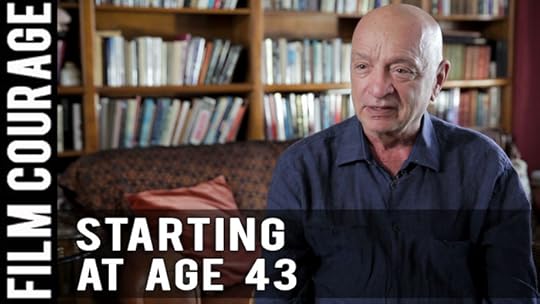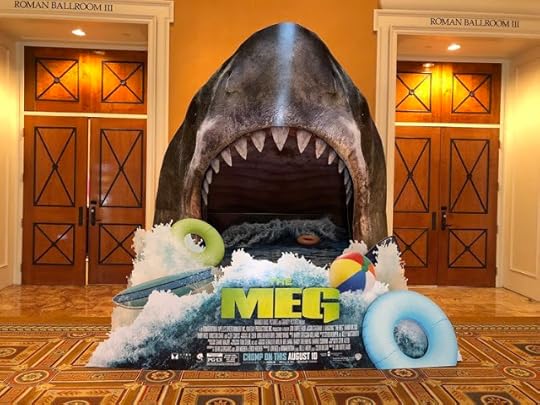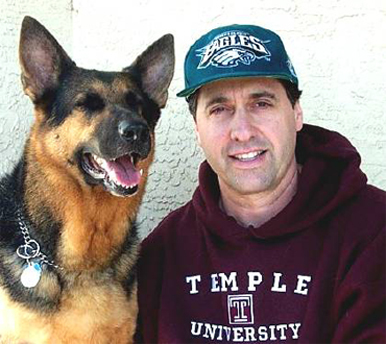Kenneth Atchity's Blog, page 120
April 29, 2018
Fundinmental Review: Voodoo Magic in White Witch by Larry D Thompson


I began reading this delicious novel about voodoo and Jamaica and I couldn’t help but think of James Michener. Granted, James went much further in his historical novels, but Larry gave him a run for his money in White Witch.
We begin in 1812 Jamaica. Annie Palmer is not only a sadistic plantation owner, she is a black widow. She mates and she kills. She is an Obeah priestess, the White Witch.
I love the Caribbean. It is my favorite travel destination. To me, nothing compares to the raw beauty and power of the islands. The mix of the old and the new draws me into the mix of the tumultuous world of voodoo and bauxite mining, greed and history will be bumping heads in a big way. For some reason, lately I have been reading a lot of books that deal with mining…and it is never in a good way. Is it a current theme in the publishing and writing world? No matter, I am eager to begin.
Will is rough, tough, a o nonsense kind of guy. Right off you know better than to push him too far. He’s a decorated Seal and he’s head of security for Global American Metals. I start off not liking the guy. Can he redeem himself in my eyes? We shall see.
He’s sent to Jamaica to smooth the ruffled feathers of the Maroons, who have plenty to say about the strip mining of their tropical rain forest.
A tropical rain forest, an unhappy nation of Maroons, a curse, voodoo, and now a dead body. Let’s rock!
All the ugliness of corporate greed rears its ugly head. The only reason I am not super ticked off is because I believe the destruction of the rain forest, at least if Annie has anything to say about it, will never happen.
It takes a novel like this to make some people think about the environment, let alone a rain forest. I love when novels contain important elements of real life, making them more believable.
White Witch by Larry D Thompson is so much more than what I was expecting. The twisting and turning, the mystery and danger, the tension and suspense kept me reading into the wee hours of the morning. I love when an author can incorporate fact and fiction with a little mysticism into an adventure that makes me see an exotic tropical island in a new light. I knew some of Jamaica’s history from reading and visiting this world tropical paradise. That makes it easier to get lost in the story.
Read more

Published on April 29, 2018 00:00
April 27, 2018
From the Writer's Trenches Marilyn Horowitz

One good thing about all of the snow was that it felt great to stay inside and write. As I sat writing and watched the big white flakes fall, I marveled when I remembered that each snowflake is unique, in the same way that each of our stories is unique.
One of the principles I use when developing a new TV series or screenplay is to encourage the writer to be as specific as possible. The more specific we are, the more universal we are. By embracing your personal past, ethnicity and race, the better the work gets, and the deeper the connection with the intended audience.
I met with my friend, Ken Atchity last week. Ken is a former professor turned producer, and is rare combination of erudite erudition, streetwise savvy and kindness. He has just written a new book, Sell Your Story To Hollywood: Writer’s Pocket Guide To The Business of Show Business.
There’s a lot of meaty information, but one thing that really spoke to me was his advice to writers when waiting for a meeting, for the deal to close, or production to happen. DON’T WAIT! Do something while you wait.
Work on a new project. Every story has it’s own flow and it can take 10 minutes or ten years to set up a project. One of my colleagues just sold a project to Netflix that took ten years!
Ken quotes Ray Bradbury: “ Start writing more. It’ll get rid of those moods you’re having.”
I’m looking forward to speaking to FilmMakeHers, a dynamic group of women dedicated to furthering their careers in the business. I will be giving a talk about how to use The Four Magic Questions Of Screenwriting when structuring a film or TV pilot. I’m planning to have the attendees use the technique to either structure a new story, or review one they are currently working on during the three-hour class. It’s so exciting to work on new stories with new people!
Ask you write, consider how your personal history can successfully influence your work, and appreciate your own uniqueness.
Here's to your successful writing!
Professor Marilyn Horowitz

Published on April 27, 2018 00:00
April 25, 2018
There Are 3 Ways To Break Into Hollywood And I Didn’t Use Any Of Them by Dr. Ken Atchity

Watch the video interview on Youtube here
Film Courage: What key steps did you take to go from being a tenured professor? Most people would do many things that aren’t good to be in those shoes. I’m sure first of all you had to deal with social pressure, people were probably trying to talk you out of it…maybe not? What steps did you take?
Dr. Ken Atchity, producer/author: Well…in retrospect you can always make it look more planned and logical than what it was at the time. But I basically…I ran into a very inspiring many whose name is Norman Cousins who was the editor of Saturday Review world of those days and he came to speak in a class of mine at Occidental College and it turned out we shared a motto that no one else in the world had ever heard of and that motto was a single sentence by the Spanish philosopher [José] Ortega y Gasset that said “I think the only immoral thing is for a being not to use every instant of its existence with the utmost intensity.” And I had never heard anyone else quote that, but after his talk in my class I asked him to come to my office and I showed him that it was framed above my desk and so needless to say we bonded. Long story short, I asked him what I should do when I grow up which I’d asked male authority figures all my life basically. He told me after we got to know each other that I should consider the entertainment business because it was much broader than the academic world and people can basically do whatever…anything creative you’re encouraged to do basically. You can find your own way. There are no rules and schedules and all of those kind of things that we find in academia.
And I love academic you know? The world and the ideas that are exchanged and all of that. But it was restricting and it was (for me) suffocating. Which is a word that means a lot to me personally. It’s my most ancient nightmare being suffocated and I’ve never been suffocated in the…(Watch the video interview on Youtube here ).

Watch the video interview on Youtube here

Published on April 25, 2018 00:00
April 24, 2018
The Meg Standee from the floor of CinemaCon!
The Meg standee will allow you to take a photo inside the mouth of a shark, which should make for a fun social media pic! So keep your eyes peeled, Meg-heads.




Published on April 24, 2018 04:28
April 23, 2018
April 21, 2018
Film Courage: Starting at Age 43

Watch the video on Youtube here
Film Courage: Ken, as a tenured professor in your mid-40s, what made you think you could change careers?
Dr. Ken Atchity, producer and author: Well, this is America and you can do whatever you want to do. It’s one of the great things about this country.
What I was doing was very related to a career I’m in now. It was developing stories, developing writers, and of course, teaching a number of things that I no longer teach like classical literature and Italian literature.
So it’s all united by storytelling. I had no idea which world was sort of the bigger world of ideas, the world of academia that I had been in for 17 years, or the world I went into. And I discovered that the world I went into was really the world of ideas, because it’s a world in which people are tracking ideas across continents to find out who owns the rights to a story.
They pay lots of money to acquire the story (at least they used to pay lots of money) and they spend millions of dollars to turn the story into a movie and they’re fiercely competitive about the world of ideas. The motion picture business is the jungle of ideas and it’s survival of the best idea and the best business people.
I always so it’s called show business for a reason. It’s not just about show, it’s about the business of how stories get developed into movies that the whole world can see.
Film Courage: I’m hoping we can go back to maybe before you made this transition to wanting to be in film? Was there something that happened, was there a time in your life that where you felt like “You know what? I want a new challenge.”
Dr. Ken Atchity: That’s a good question because I’ve reflected on it all of my life since then and it was actually provoked by my receiving tenure. I actually belonged to an untenured faculty committee against tenure. One day when I was a Fulbright professor in Bologna, Italy, I got a telegraph from the Dean of the faculty at Occidental College telling me that I’d received tenure in my absence.
And my reaction to it was not very understandable to my friends and colleagues. I became deeply depressed for about a year. And it took me a long time to figure out why I was depressed and it was because I had really never asked to be in this golden cage where nothing can happen to you. It was like the most secure place you could be and I realized at the time that my father’s chief value in life was security. He was a child of The Depression and security was all important to him. And I had to admit to myself that it wasn’t that important to me. I never worried about being secure. I’d published lots of things and I was in demand as a speaker and just never had to worry about it.
And what I valued was freedom and I didn’t feel and I didn’t feel freedom when under a structure where you had to behave a certain way and you had to know a year in advance that on the week of October 12th you’d be teaching the 8th book of The Iliad. And it was wonderful to be teaching The Iliad, but that to know a year in advance you were going to be somewhere.
I now live in a world where I don’t know where I am going to be tomorrow literally and it’s complete opposite, it’s a free world. And of course I realized that as I got older that freedom is as much an illusion as security (both of them are illusions), but it was my illusion. Security was not my illusion and so I’ve lived with complete insecurity. But with the freedom to express myself creatively and in every possible way (which is what the film business allows me to do) and so that was very exciting to me.
Film Courage: And do you ever tell people that? If they are looking to be in a creative pursuit whether it’s being an author or screenwriter or actor, that security will probably be something that they will not encounter and to be okay with that?
Dr. Ken Atchity: Absolutely. I mean this is not a career to wish on anyone. You have to have a burning desire to do it and you have to be willing to sacrifice anything to do it and to persist despite every setback and I can tell you that this is a business in which (a career) this never gets easier, I don’t care how many movies you’ve done. The next one is going to be the biggest challenge you’ve ever faced, the world changes all the time. It’s been changing ever since I’ve been in it which is around 30 years now and it never gets any easier and it never gets any more secure and even if you’ve had windfalls and lot.
Read more

Published on April 21, 2018 00:00
April 20, 2018
Entertaining Options: Diving deep with Steve Alten, author of “The MEG”

For over two decades, readers have been spellbound by the gripping writing of Steve Alten. His absorbing work has traversed the entire timeline of existence from the dawn of life on earth to 12 million years in the future. He mingles fact with fiction to create mesmerizing tales of wonder driven by a palpable sense of urgency. However, as solid as his writing has remained over the past 22 years, behind the scenes, his career has been filled with vacillating waves of unfathomable twists and turns that have resulted in both devastating gut punches and rousing triumphs.
This year, after decades of struggles and false starts, the world will finally get to experience Steve’s work in a vibrant new way. On August 10, The MEG will hit the big screen in what is being touted as the blockbuster movie event of the summer! In this Q&A, Steve was completely open about his amazing journey to this point in his life.
Could you share your personal story about your roller coaster career as an author?
Well, I have always loved shark stories, ever since reading JAWS as a teen. After reading Benchley’s novel, I went straight to the library and checked out every true-life Great White shark attack story… in the process I came across little blurbs about Megalodon, the prehistoric cousin of the Great White, usually accompanied by a black & white photo of six scientists seated in a MEG jaw. But there was nothing else out there.
Flash forward 20 years: Despite ten years of college and a doctorate degree in education, I was struggling to support a family of five. I tried multi-level marketing while I was selling whole house water treatment systems… or I should say not selling too many of them. In August of 1995, TIME published an article on the Mariana Trench and deep water hydrothermal vents and I thought to myself… what if that big shark was still alive down there — if it’s scientifically plausible, that might make a really cool novel. So I set a goal — I’d spend 30 days researching the story in the library (there was no internet back then) and write 3-4 pages a night (from 11 p.m. until 3 a.m.) and weekends.

Six months later, I had a 400+ page manuscript but no connections in publishing, so I bought a book on how to get published. Following the instructions, I sent out 2-page query letters to every literary agent who handled fiction. About 70 letters went out… only one agent saw the vision — Ken Atchity at AEI. To pay for editing fees, I sold my 1971 Chevy convertible — a gift from my father when I was seventeen. I also took a job working as a sales manager for a wholesale meat company, and was eventually promoted to GM… crazy story. Anyway, working with an AEI editor, I rewrote the manuscript that became MEG.
On September, Friday the 13th in 1996, I came to work, only to learn I no longer had a job. I drove home to tell my wife, “This is the best thing that could have happened honey, now I can work on my next book.” She was upset — we were down to our last $48. Four days later, Ken started a bidding war for MEG’s publishing rights, which weeks earlier had received a first rights offer from Disney’s Hollywood Pictures, and the rollercoaster that has been my life these last 22 years began.
The ups included a two-book, seven figure deal from Bantam-Doubleday, the house that published JAWS. MEG hit every best-seller list, including #19 on the NY Times list (#5 audio) while Bantam-Doubleday sold the foreign rights for over $1.3 million. The downs — my second book deal was cancelled two weeks before I was to be paid a lot of money (a lot of authors who received big advances were canned just before Bertlesmann took over the company). Then the president of Hollywood Pictures was fired and the movie rights were reverted. Total money lost — over $1,500,000.
Bye-bye new house, bye bye new cars… I basically had to start over again. Plus, we had to sue to get the rights back to my second story, a thriller about the Mayan Doomsday prophecy in 2012, which my editor wanted to be another underwater thriller. I gave them what they wanted… but it was not a good book.
Flash ahead to 2005: Having schooled myself on becoming a better writer, I wrote the MEG sequel, The TRENCH (Kensington), and it too was a best-seller. We eventually got the rights back to the Mayan Doomsday book that was cancelled by Bantam-Doubleday and I rewrote the entire book. It was released by Tor/Forge in the States as DOMAIN. Years later, it was sold under the name The Mayan Prophecy and it was #1 in Spain, Mexico, and Argentina and a big seller in Europe. I also wrote and published Resurrection (Domain part 2), Goliath, and The LOCH.
Thanks to my friend, Nick Nunziata and his friends, producer Lloyd Levin and Guillermo del Toro, we put together a package for MEG with a script I had penned with director Jan de Bont. New Line Cinema optioned MEG, but the new screenwriter sidestepped the novel and basically rewrote Moby Dick with a shark. The studio wanted rewrites, but the foreign rights were undersold, killing the ability to underwrite the budget. After two years of chaos among the producers and studio, the rights again reverted back to me.
cover
Artwork from “MEG,” a 6 part monthly comic series from http://www.dabelbrothers.com.
In retrospect, these negatives were good things in that it forced me to become a much better writer, plus MEG eventually ended up in the right person’s hands. But the stress took its toll on me and in 2006 I was diagnosed with Parkinson’s Disease.
In 2007, I optioned MEG’s movie rights to producer Belle Avery and continued writing. The SHELL GAME (best-seller), MEG: Primal Waters, MEG: Hell’s Aquarium (best-seller), Grim Reaper, SHARKMAN, The OMEGA PROJECT (top 4 summer selection by Barnes & Noble), VOSTOK, and UNDISCLOSED. Meanwhile, Belle Avery was working her magic. After seven long years of hard work and perseverance, Belle Avery, Gravity Pictures, and Warner Bros. are about to bring The MEG into theaters (the trailer debuts in theaters on my good luck day — Friday the 13th (of April 2018), the movie releasing on August 10).
I am currently finishing my sixth and best MEG novel, MEG: GENERATIONS. It will be out in June, but the hardback can only be purchased at www.SteveAlten.com by pre-ordering through April and won’t be sold in stores or on Amazon. The ebook will be available in June. It’s a strange marketing plan for sure, but I wanted to do something special for my MEGheads — my loyal MEG fan base.
What did you learn about storytelling from finishing that first book?
Ken taught me a lot. He said writing a book is like preparing a fish to cook — you cut off the head and tail and start with the meat in the middle. I also learned a lot about beat sheets and organizing the skeleton of the story — all things I have passed down to my WRITING COACH students, six of whom have also been published.
Is Ken Atchity still your manager?
We had parted ways after the New Line deal ended, but recently found each other again and he is once more my manager. Danny Baror at Baror International continues to manage all foreign rights to my books.
Are there any other Alten novels optioned for TV or movies?
Yes. Belle and her team have optioned The LOCH for theatrical release, and my series SHARKMAN has been optioned for TV. I also have several books that Ken will take out soon, including a laugh-out-loud comedy called DOG TRAINING THE AMERICAN MALE, written under the pen name L. A. Knight.
shark still
First still from “The MEG.” Photo: Warner Bros. Pictures.
Why do you believe The MEG movie finally happened? What was the magic that made this movie not only get greenlit, but made into what sure looks like a billion dollar franchise?
In truth, it’s all about the undying passion and commitment of Belle Avery. There may be bigger name producers attached to The MEG, but make no mistake, this never happens without Belle. She resuscitated it in Hollywood and got it financed in China, then brought it to Warner Bros. She is the only person I truly trust with my work… a total team player.
Were you ever on set?
Not this time around. But my daughter, Kelsey, went over to China during the shoot. They dressed her up as an Asian girl and let her be an extra. That meant a lot to me.
Did you get to meet any of the actors?
Not yet. I sent them all signed books and look forward to meeting them at the premiere. It’s an amazing ensemble, led by Jason Statham.
What is next from Steve Alten?
I’m finishing up MEG: GENERATIONS, then it’s on to SHARKMAN-2.
Read more

Published on April 20, 2018 00:00
April 18, 2018
Dennis Palumbo on Lynn Cullen Live - Pittsburgh City Paper!
Formerly a Hollywood screenwriter, his credits include the feature film My Favorite Year, for which he was nominated for a WGA Award for Best Screenplay. He was also a staff writer for the ABC-TV series Welcome Back, Kotter, and has written numerous series episodes and pilots.
Currently, he writes the weekly “Hollywood on the Couch” column for the Psychology Today website, and blogs regularly for The Huffington Post.
The fifth book in the Daniel Rinaldi series HEAD WOUNDS is published by Poisoned Pen Press

Published on April 18, 2018 00:00
April 16, 2018
Why Mickey Mouse’s 1998 copyright extension probably won’t happen again
The copyright for the first Mickey Mouse film, Steamboat Willie, is scheduled to expire in 2024, though Disney would still hold a trademark for the Mickey Mouse brand. One guaranteed result: lots of work for lawyers.
On January 1, 2019, every book, film, and song published in 1923 will fall out of copyright protection—something that hasn't happened in 40 years. At least, that's what will happen if Congress doesn't retroactively change copyright law to prevent it—as Congress has done two previous times.
Until the 1970s, copyright terms only lasted for 56 years. But Congress retroactively extended the term of older works to 75 years in 1976. Then on October 27, 1998—just weeks before works from 1923 were scheduled to fall into the public domain—President Bill Clinton signed legislation retroactively extending the term of older works to 95 years, locking up works published in 1923 or later for another 20 years.
Will Congress do the same thing again this year? To find out, we talked to groups on both sides of the nation's copyright debate—to digital rights advocates at the Electronic Frontier Foundation and Public Knowledge and to industry groups like the Motion Picture Association of America and the Recording Industry Association of America. To our surprise, there seemed to be universal agreement that another copyright extension was unlikely to be on the agenda this year.
"We are not aware of any such efforts, and it's not something we are pursuing," an RIAA spokesman told us when we asked about legislation to retroactively extend copyright terms.
"While copyright term has been a longstanding topic of conversation in policy circles, we are not aware of any legislative proposals to address the issue," the MPAA told us.
Presumably, many of the MPAA's members would gladly take a longer copyright term if they could get it. For example, Disney's copyright for the first Mickey Mouse film, Steamboat Willie, is scheduled to expire in 2024. But the political environment has shifted so much since 1998 that major copyright holders may not even try to extend copyright terms before they start to expire again.
The politics of copyright have changed dramatically
In 2013, on the 15th anniversary of the 1998 Copyright Term Extension Act, I wrote an in-depth look at the legislative fight over that bill. I talked to Dennis Karjala, a law professor who was part of the lonely opposition to longer copyright terms in the 1990s. He died last year.
"There was not a single argument that actually can stand up to any kind of reasonable analysis," Karjala told me. But that didn't matter very much because the lobbying muscle was entirely on one side. Major movie studios joined forces with the estates of famous authors and musicians to push for a copyright extension.
Most of the public considered copyright to be a boring subject with little relevance to their daily lives, so there was little grassroots interest in the issue. Karjala hoped that professional associations of librarians and historians—which had traditionally been important advocates for the public interest on copyright issues—would help stop the bill. But the legislation had so much momentum that these groups decided to settle for minor changes to the legislation. So the bill wound up passing without a significant fight.
The rise of the Internet has totally changed the political landscape on copyright issues. The Electronic Frontier Foundation is much larger than it was in 1998. Other groups, including Public Knowledge, didn't even exist 20 years ago. Internet companies—especially Google—have become powerful opponents of expanding copyright protections.
Most importantly, there's now a broad grassroots engagement on copyright issues—something that became evident with the massive online protests against the infamous Stop Online Piracy Act in 2012. SOPA would have forced ISPs to enforce DNS-based blacklists of sites accused of promoting piracy. It was such a bad idea that Wikipedia, Google, and other major sites blacked themselves out in protest. The digital rights activist group Demand Progress emerged from the SOPA fight and has gone on to play a key role organizing protests over network neutrality and other issues.
The protest against SOPA "was a big show of force," says Meredith Rose, a lawyer at Public Knowledge. The protest showed that "the public really cares about this stuff."
The defeat of SOPA was so complete that it has essentially ended efforts by copyright interests to expand copyright protection via legislation. Prior to SOPA, Congress would regularly pass bills ratcheting up copyright protections (like the 2008 PRO-IP Act, which beefed up anti-piracy efforts). Since 2012, copyright has been a legislative stalemate, with neither side passing significant legislation.
And that means that advocates of a new copyright term extension bill wouldn't be able to steamroll opponents the way they did 20 years ago. Any term extension proposal would face a well-organized and well-funded opposition with significant grassroots support.
"After the SOPA fight, Hollywood likely knows that the public would fight back," wrote Daniel Nazer, an attorney at the Electronic Frontier Foundation, in an email to Ars. "I suspect that Big Content knows it would lose the battle and is smart enough not to fight."
"I haven't seen any evidence that Big Content companies plan to push for another term extension," Nazer added. "This is an election year, so if they wanted to get a big ticket like that through Congress, you would expect to see them laying the groundwork with lobbying and op-eds."
Of course, copyright interests might try to slip a copyright term extension into a must-pass bill in hopes opponents wouldn't notice until it was too late. But Rose doesn't think that would work.
Not only are there many more copyright reform advocates in Washington now than there were 20 years ago, but they're also well-networked with other public interest groups, she told Ars in a phone interview. As a result, there are "a lot of different eyes on different bills."
"The likelihood of it slipping by unnoticed" is low, Rose said.
And even some content creators aren't keen on ever-longer copyright terms. The Authors Guild, for example, "does not support extending the copyright term, especially since many of our members benefit from having access to a thriving and substantial public domain of older works," a Guild spokeswoman told Ars in an email. "If anything, we would likely support a rollback to a term of life-plus-50 if it were politically feasible."
In my 2013 article, I wrote that "the question for the coming legislative battle on copyright is who will prevail." But now it looks like there probably won't be a legislative battle at all because hardly anyone is pushing for another extension. And that means we might actually see works start to fall into the public domain next year.
Read more

Published on April 16, 2018 00:00
April 15, 2018
The Meg Photo Gallery
Published on April 15, 2018 00:00








